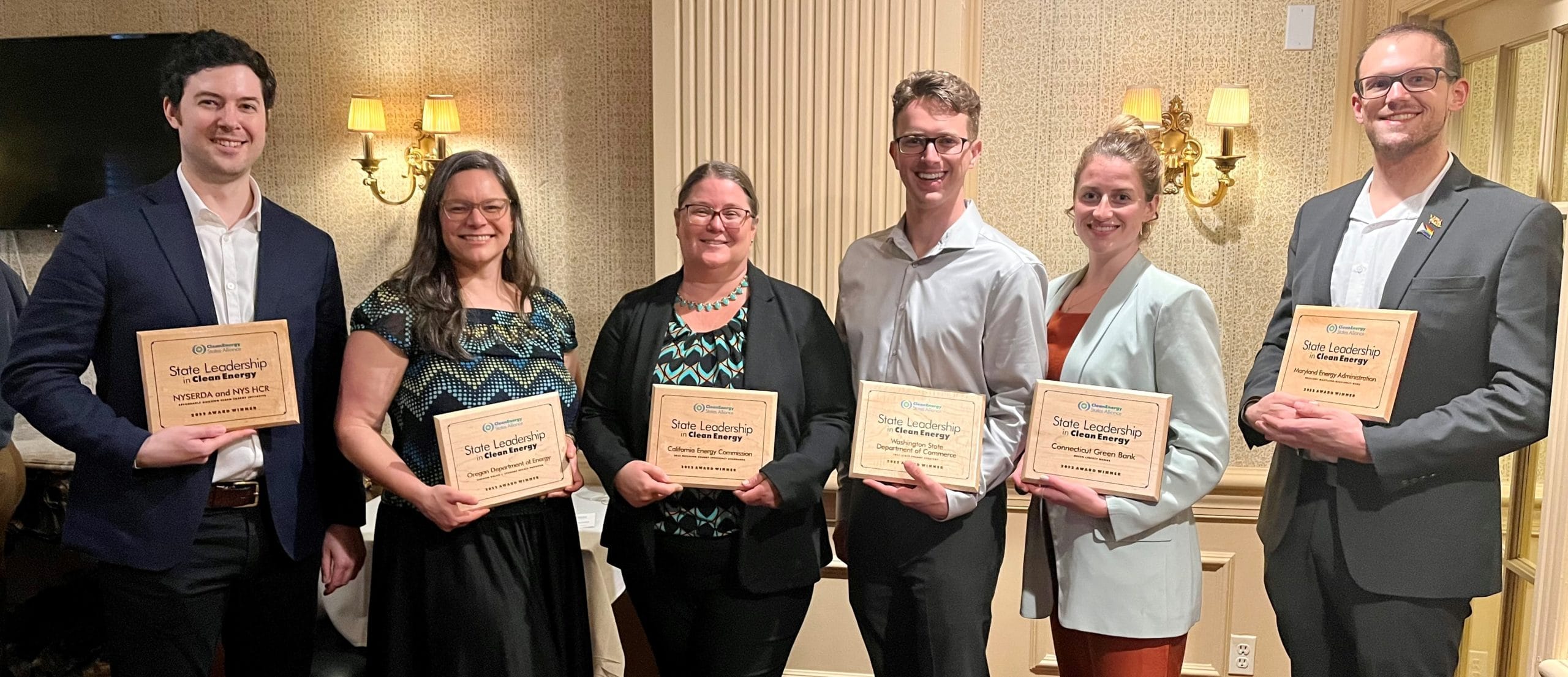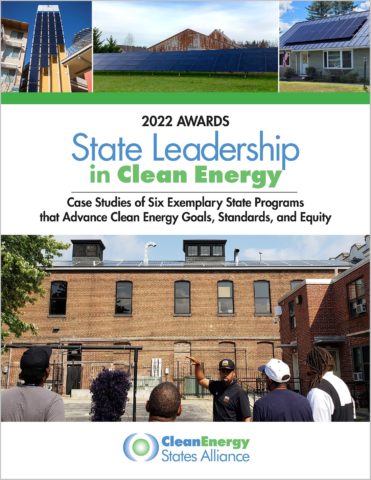Project Menu
2022 State Leadership in Clean Energy Awards

 The Clean Energy States Alliance is pleased to announce the recipients of the 2022 State Leadership in Clean Energy Awards. Since 2009, the biennial Leadership Awards have recognized outstanding state programs and projects that have accelerated the adoption of clean energy technologies. The six winners were chosen by an independent panel of judges, and were evaluated based on leadership, innovation, cost-effectiveness, and replicability.
The Clean Energy States Alliance is pleased to announce the recipients of the 2022 State Leadership in Clean Energy Awards. Since 2009, the biennial Leadership Awards have recognized outstanding state programs and projects that have accelerated the adoption of clean energy technologies. The six winners were chosen by an independent panel of judges, and were evaluated based on leadership, innovation, cost-effectiveness, and replicability.
“States across the country have been taking strong and creative action to expand the use of clean energy,” said CESA Executive Director Warren Leon. “These award winners highlight the important, innovative, and diverse ways that states are moving clean energy forward.”
Case studies of the winning programs are highlighted in a report - read it here.
This year’s awards were presented to the following at a reception in Washington, DC on June 7th.
- California Energy Commission (CEC) for the California Building Energy Efficiency Standards (2022 Energy Code) for newly constructed buildings and renovated buildings. The 2022 code blazes a trail for states seeking to decarbonize the building sector aggressively and cost-effectively. This update includes electric heat pumps as the performance standard baseline for single-family homes, multifamily homes, and select commercial buildings. It also includes a first-in-the-nation standard for solar-electric systems plus battery storage for select nonresidential building types, including high-rise multifamily, hotel/motels, medical clinics, retail stores, restaurants, and schools. Over the next 30 years, this code is estimated to provide the state with $1.5 billion in environmental benefits, equivalent to taking nearly 2.2 million cars off the road for a year. The development of this code was a multiyear effort led by the CEC through a robust public process and with support from an expansive network of key market partners, including California’s largest utilities, the building community, and environmental advocates. According to the judges: “Energy codes are a powerful lever for change, and the California Energy Commission has pushed the envelope and raised the bar for what is possible for building codes and clean energy. These codes serve as a good reference point for other states.”
- Connecticut Green Bank for Green Liberty Bonds. Modelled after the War Bonds of the 1940s, Green Liberty Bonds are purchased by individual investors in lower-dollar denominations (the bonds are offered in $1,000 increments), enabling people to directly participate in the green economy and earn a return on their investment. The proceeds of Green Liberty Bonds are invested in projects that confront climate change in Connecticut. The bonds are Climate Bond Certified and currently carry a rating by S&P of A+. They are backed by a unique revenue stream created by the sale of Solar Home Renewable Energy Credits (SHRECs), which are generated by solar panels on homes. The first issuance of the Green Liberty Bonds in July 2020 sold nearly $17 million, and the second issuance in May 2021 sold nearly $25 million. According to the judges: “The Green Bank has created an interesting, innovative, and highly creative way to generate revenue for clean energy projects and to increase public benefits from—and greater public participation in—investments that will accelerate funding for clean energy deployment in Connecticut.”
- Maryland Energy Administration (MEA) for Resilient Maryland / Resiliency Hubs Grant Program. MEA’s resilience programs aid Maryland organizations to develop resilient energy system projects that bolster their operations, protect communities, enhance sustainability, and achieve energy affordability. Resilient Maryland provides funds to local organizations to help pay for feasibility analyses, preliminary modeling, and other important preconstruction activities in the development of microgrids, resilient facility power systems, and resiliency hubs for Maryland communities, businesses, and critical infrastructure. The Resiliency Hub Program provides capital funds for the installation of solar PV and battery storage systems that enable them to become “resiliency hubs,” which are sited in local, community-serving locations where residents can access electricity during grid outages to power their essential electrical devices, to refrigerate temperature-sensitive items, and to shelter in safety. According to the judges: "Maryland Energy Administration’s suite of resiliency programs are well designed, with holistic project evaluation criteria and ample opportunity for community input on system configuration. These programs will help support low-income and medically vulnerable communities by providing access to solar and battery storage systems during outages.”
- New York State Energy Research and Development Authority (NYSERDA) and New York State Homes and Community Renewal (HCR) for the Clean Energy Initiative (CEI). NYSERDA and HCR have partnered to provide incentives and technical assistance for decarbonization of multifamily affordable housing developments in New York State. NYSERDA is providing $100 million for this joint initiative to support electrification and high-performance envelope improvements to existing and new construction affordable housing. The Clean Energy Initiative provides a replicable and scalable model to accelerate decarbonization of affordable housing. Moreover, this collaboration and the resources provided by NYSERDA have positioned HCR to propose an additional $750 million in incremental funding for decarbonized, all-electric housing in its upcoming Five-Year Housing Plan. This will allow more New York families to benefit from healthy, clean energy homes, while providing housing developers with streamlined access to technical assistance and clean energy incentives to support decarbonization. According to the judges: “The Clean Energy Initiative tackles a challenging sector with an innovative and de-siloed approach for technical assistance and funding. The positive equity impacts from the decarbonization of affordable housing can be long-term and transformative. NYSERDA’s long-term vision is excellent, and the partnership with the housing authority [NYS-HCR] will help remove barriers to clean energy expansion.”
- Oregon Department of Energy (ODOE) for the Oregon Solar+Storage Rebate Program. This program offers rebates to residential customers and low-income service providers that install solar or solar paired with battery storage systems. At least 25 percent of rebate funds each year are reserved for low- or moderate-income residential customers and low-income service providers, with higher rebate amounts available to these groups. ODOE collaborated with Oregon Housing and Community Services, the solar industry, and other energy partners to develop a streamlined, stackable, and cost-effective process to determine income eligibility for program participants and maximize incentives for project cost savings. The 352 completed projects that received a rebate in the first round of funding represent solar electric generation that is estimated to displace 2,193 metric tons of carbon dioxide equivalent per year. According to the judges: "This Oregon Department of Energy’s solar plus storage rebate program was thoughtfully designed to maximize participation by low income communities, with impressive results. ODOE’s ability to collaborate with other agencies on eligibility pathways was a good approach to increase the program’s accessibility.”
- Washington Department of Commerce - Energy Office for the 2021 State Energy Strategy. The strategy was produced to provide a roadmap for Washington to meet its critical and ambitious energy and climate goals: transitioning to 100% clean electricity by 2045 and reducing greenhouse gas emissions in accordance with climate science. It combines detailed modeling with extensive stakeholder and technical input to identify actions in every major sector of the state’s economy. The strategy puts equity and climate justice first because climate change will inflict greatest harm on overburdened communities and low-income households. This work was guided by a 27-member advisory committee representing a broad set of governmental, Tribal, environmental, consumer, and industry interests. Washington contracted for professional meeting facilitation for the advisory committee. The state also actively engaged political leaders and offered multiple opportunities for public input and review. The strategy’s impact has been substantial, with at least 40 legislative measures referencing it, and it has led to the development of a comprehensive cap-and-invest program, a low carbon fuel standard, a comprehensive environmental justice statute, and substantial new investments in broadband access, clean energy development and regulatory reform. According to the judges: “With the 2021 State Energy Strategy, Washington has demonstrated a deep commitment to meaningful community engagement and centering equity concerns. The impacts from this effort were impressive; they effectively used modeling tools and community engagement at the start of the process to influence a variety of policy decisions.”
The judges who donated their time to assess the programs nominated by state agencies across the country were: Lori Bird, World Resources Institute; Shanna Cleveland, Energy Foundation, Paula Garcia, Union of Concerned Scientists; Olivia Nedd, Vote Solar; and Ben Passer, the McKnight Foundation. The judges’ participation in this process in no way connotes their respective organizations’ endorsements of these programs. (Note that Shanna Cleveland recused herself from deliberations about the Connecticut Green Bank.)
Webinar Series
CESA will host a webinar series with representatives from the award-winning programs who will present their work in three events:
- State Leadership in Decarbonizing the Building Sector, Featuring California and New York, Wednesday, October 26, 1-2:30pm ET
- Innovative Avenues to Public Participation in Clean Energy Development, Featuring Connecticut and Washington, Wednesday, November 9, 1-2:30pm ET
- State Leadership in Solar+Storage, Featuring Maryland and Oregon, Friday, December 9, 2-3:30pm ET
These webinars are free to attend, but registration is required.
***
Photos of the award winners are available here.


